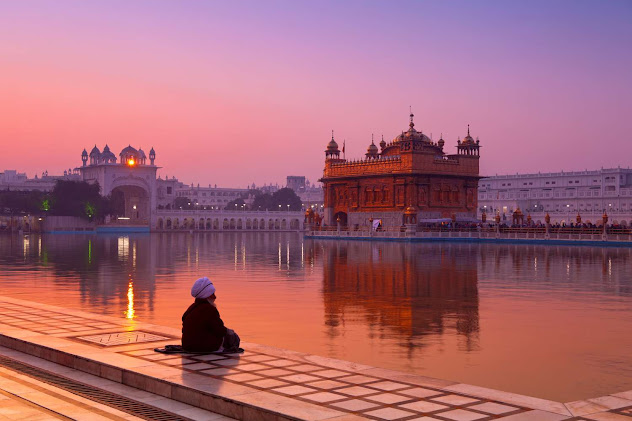Tour Of Gurudwara In India Tour By Train
Exploring the Gurudwaras of
India via train offers an immersive and enriching experience, blending
spiritual discovery with the adventure of travel. This pilgrimage traverses the
length and breadth of India, taking devotees through historical sites, cultural
landmarks, and picturesque landscapes. From the majestic Golden Temple in Amritsar to the serene Hemkund Sahib in the Himalayas, each Gurudwara holds its
own significance, inviting pilgrims to deepen their connection to Sikhism and
embark on a journey of self-discovery.
The journey typically begins
in Delhi, the bustling capital city that serves as a gateway to the spiritual heartland of India. Pilgrims gather at the railway station, brimming with
anticipation and excitement for the adventures that lie ahead. As they board
the train, they are filled with a sense of reverence, knowing that they are
about to embark on a sacred voyage that will leave a lasting impact on their
lives.
The first stop on this
spiritual odyssey is often Amritsar, home to the iconic Golden Temple, or Harmandir Sahib. As the train pulls into the station, pilgrims catch their
first glimpse of the resplendent gilded structure, which stands as a symbol of
Sikhism's enduring spirit. Stepping off the train, they are greeted by the
melodious sounds of Gurbani and the fragrance of incense, signaling their
arrival at a place of great sanctity.
The Golden Temple is not
merely a place of worship; it is a vibrant center of Sikh culture and heritage.
Pilgrims marvel at its architectural splendor, with its glistening gold-plated
dome reflecting in the tranquil waters of the surrounding sarovar, or holy
pool. They join the throngs of devotees as they circumambulate the temple,
offering prayers and seeking blessings from the Guru Granth Sahib, the holy
scripture of Sikhism.
One of the most cherished
rituals at the Golden Temple is partaking in the langar, or community meal,
which is served free of charge to all visitors regardless of caste, creed, or
religion. Pilgrims eagerly volunteer in the langar hall, helping to prepare and
serve food to the thousands of devotees who flock to the temple each day.
Through this act of seva, or selfless service, they experience the true essence
of Sikh teachings on equality and compassion.
From Amritsar, the journey
continues to other significant Gurudwaras in Punjab, such as Anandpur Sahib,
where Guru Gobind Singh Ji established the Khalsa Panth, and Takht Sri Keshgarh
Sahib, one of the five temporal seats of authority in Sikhism. Each Gurudwara
holds its own historical and spiritual significance, offering pilgrims a deeper
understanding of Sikh history and philosophy.
As the train winds its way
through the verdant fields and bustling towns of Punjab, pilgrims engage in
heartfelt conversations with fellow travelers, sharing stories of faith and
devotion. The train becomes a microcosm of the larger Sikh community, where
bonds are forged and friendships are made that transcend barriers of language
and culture.
Beyond Punjab, the pilgrimage
takes pilgrims to Gurudwaras across India, from historic sites in Delhi such as
Bangla Sahib and Sis Ganj Sahib to remote mountain shrines like Hemkund Sahib
in Uttarakhand. Each destination offers its own unique charm and allure,
inviting pilgrims to explore the diverse tapestry of Sikh heritage.
In addition to visiting
Gurudwaras, pilgrims also have the opportunity to explore the rich cultural
heritage of India, from the majestic forts and palaces of Rajasthan to the
serene backwaters of Kerala. Along the way, they sample regional cuisines, shop
for souvenirs, and immerse themselves in the vibrant colors and sounds of the
country.
Throughout the journey,
pilgrims are accompanied by knowledgeable guides who provide insights into the
history and significance of each Gurudwara. They also organize cultural
programs, spiritual discourses, and interactive sessions to enrich the
pilgrimage experience and foster a sense of community among the participants.
As the pilgrimage draws to a
close and the train makes its way back to Delhi, pilgrims carry with them
memories that will last a lifetime. They return home with a renewed sense of
purpose and devotion, inspired by the teachings of the Gurus and the warmth of
Sikh hospitality. Though the physical journey may come to an end, the spiritual
journey continues, as pilgrims strive to embody the values of love, humility,
and service in their daily lives.
In conclusion, the tour of
Gurudwaras in India by train is not just a sightseeing excursion; it is a profound
spiritual journey that nourishes the soul and deepens one's connection to
faith. Through visits to sacred shrines, acts of seva, and moments of
reflection, pilgrims embark on a transformative odyssey that leaves an
indelible imprint on their hearts and minds. It is a journey of faith, love,
and devotion, where the destination is not a place on a map but a state of
being that transcends the physical realm.




Comments
Post a Comment